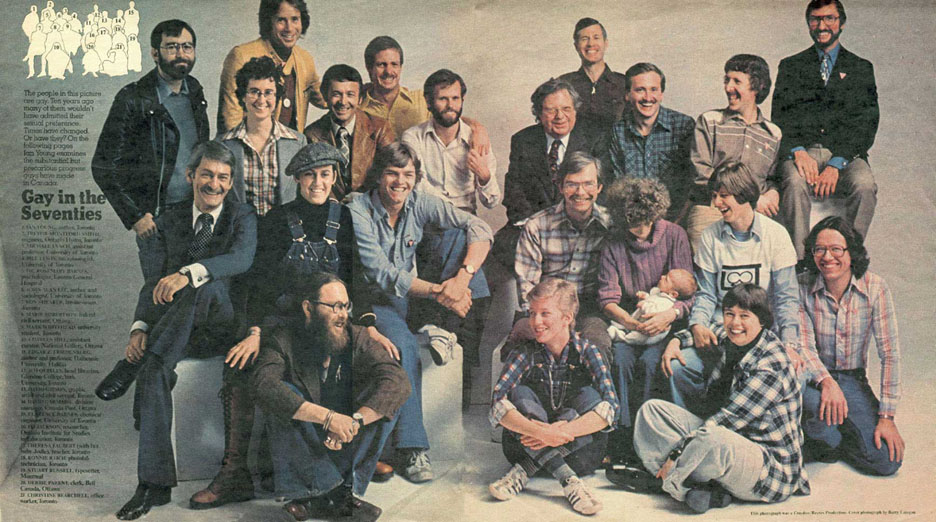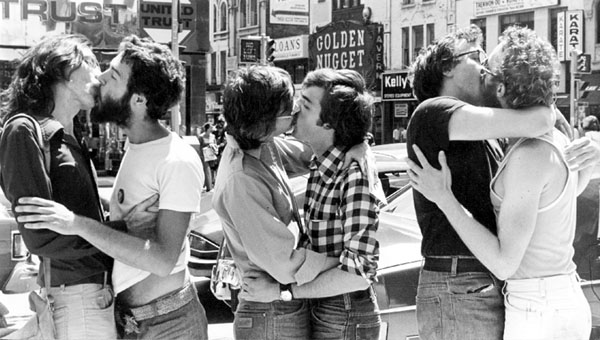|
On Aug 28, 1971 the first demonstration by lesbians and gays in Canada was held in Ottawa with a simultaneous demonstration in Vancouver. Participants in the Ottawa demonstration came from across Ontario and Quebec. They presented to the government the Toronto Gay Action brief, entitled "We Demand" (see video clip). The brief laid out ten demands to end discrimination against homosexuals ranging from criminal code changes to human rights protection; including a demand to end the ban on homosexuals coming into the country and a demand to know if the government was investigating gays working in the public sector. Among the spokespersons at the demonstration was Charlie Hill, then a member of the Homophile Association at University of Toronto and later, Gays of Ottawa. The ten demands that they put before Parliament that day set the agenda for lesbian and gay rights for the next thirty years. (see photos: "We Demand", Ottawa, 1971.) This was the first public demonstration by gays and lesbians in Canada. It represented the beginning of a movement; a new generation inspired by the Civil Rights movement of American blacks, the birth of the women's liberation movement and the anti-Viet Nam War movement (see video clip "Out of the closet"). Their response to the decriminalization of homosexuality in Canada in 1969, in the now famous words of Trudeau "the state has no place in the bedrooms of the Nation" was to point out that the 'right to privacy' did not mean an end to discrimination. Instead, gay liberationists demanded to live openly and they encouraged lesbians and gay men to come out of the closet. Where previously the experience of gays and lesbians had been isolation, repression and fear, gay liberation represented a new, radical, grass roots movement. Not limited to a narrow 'rights' agenda; gay liberation focused on attaining rights and equality as a framework to inspire a social movement and to challenge discrimination. As Chris Bearchell recalled, "we saw the gay rights strategy as something that would radicalize, politicize and mobilize people" (see photos: "Gay Liberation"). Throughout this period a number of new organizations sprang up including a series of Pan-Canadian Gay Rights Conferences. These conferences gave birth to the National Gay Election Coalition in 1973, which hounded Prime Minister Trudeau at election rallies throughout the 1974 campaign. And on the weekend of July 1st , 1975 the National Gay Rights Coalition (NGRC) was founded at a national conference in Ottawa, as a civil rights organization. Its goals were "the removal of all federal legislation which permits, condones or encourages discrimination against homosexuals" and "the implementation of legislatively guaranteed civil rights for gay people." (see photos: NGRC, Ottawa, 1975) The three regional centres of the national movement were the Gay Alliance Towards Equity (GATE) in Vancouver, the Coalition for Gay Rights in Ontario (CGRO) and GATE, Toronto and l'Association pour les droits des gais du Quebec (ADGQ). These groups formed the political leadership of the gay liberation movement. Stand Together looks at the Ontario based part of this history focusing on the first decade of the Coalition for Gay Rights in Ontario. Gay Liberation organizations developed across the country from the Maritimes to the Gay Alliance Towards Equity (GATE) in Vancouver, the Coalition for Gay Rights in Ontario (CGRO) , GATE Toronto and l'Association pour les droits des gais du Quebec (ADGQ). Much of the early organizing effort of gay liberation groups was focused on overcoming the isolation gay men and lesbians experienced and engaging in public education against widespread homophobia; setting up phone lines, services, dances, social events. The movement emphasized visibility and encouraging people to come out of the closet as a necessary pre-condition to building a movement for social acceptance and an end to oppression. As lesbians and gays came out they encountered wide spread homophobia. In the early seventies, The Body Politic emerged as an important and hard-hitting national gay liberation newspaper. One article entitled: "The Halloween Phenomenon " focused attention on the organized gay bashing of drag queens on Yonge Street in Toronto on Halloween. "For years this peculiarly Toronto phenomenon had grown from a small drag charade at the old Letro's bar on King St. to the twilight underground's equivalent of a Hollywood movie premiere - complete with flashbulbs, almost-limousines and police cordons holding back the shoving crowds" ( the BP, Sept. 1972). Crowds used to form in front of the Charles Street Tavern on Yonge street for the purpose of hurling eggs and insults at drag queens. In response to this the gay community organized "Operation Jack-o-Lantern", the first gay defense group, which patrolled the back alleys to defend gays from attacks (see video: "Operation Jack-o-Lantern"). The demand for human rights protection emerged by the early seventies. In 1974, GATE, the Gay Alliance Towards Equality organized a picket of the Ontario Human Rights Commission calling for the inclusion of protection on the basis of sexual orientation. (see photos: GATE pickets the OHRC). Ten years after the Criminal Code Amendments, the Toronto Globe and Mail (December 17, 1977) published a weekend news special "Gay in the Seventies" flying in gay liberation leaders for a photo-op. The same issue included an opinion survey which gauged public attitudes towards gays and lesbians. An accompanying article entitled: "Most Canadians think homosexuals are "sick" people" found that while 70% of those surveyed agreed that homosexuality should not be criminalized -- the survey noted: "But Canadians tend to think of homosexuals as sick people and dislike the idea of their holding jobs involving children. Rating homosexuality on a scale from 1 (illness) to 7 (sexual preference), 47 % feel homosexuality is more an illness than a preference... And 65% feel that public displays of affection between two men, such as holding hands, are offensive; only 13 percent find it pleasing." This later point was a direct reflection of gay liberation's confrontation with social attitudes and state proscriptions against gay visibility. A year and half prior to the Globe and Mail survey, the Gay Alliance Towards Equality in Toronto had organized a public "kiss-in" demonstration on July 17 1976. The demonstration was to protest the fact that two men had been found guilty of committing an indecent act for kissing on Bloor Street in Toronto.
Given the widespread nature of homophobia across society, the need for human rights protection on the basis of sexual orientation became an important goal of the movement - for more on the strategy and mobilization to win greater rights and freedoms, see Human Rights. Acknowledgement: I am indebted to Tom Warner, for his tireless support, consultation and perspectives while I was working on Stand Together. For more on the history of gay liberation in Canada and the Coalition for Lesbian and Gay Rights in Ontario, see Tom's wonderful book: Never Going Back! U. of Toronto Press, 2002. |
|
|
video clips |
|
|
"Out of the Closet"
|
Out of the Closet: (2:38:04) Interviews with
Denis LeBlanc and John Duggan (Gays of Ottawa), Ken Popert (the Body
Politic), Marie Robertson (Lesbian Collective of Waterloo and Gays of
Ottawa) and Chris Bearchell (Coalition for Gay Rights in Ontario, the
Body Politic, Gay Alliance Towards Equality). |
|
"We Demand" (2:54:00) Charlie
Hill: a spokesperson for the 1971 demo and then a member of the Homophile
Association at the University of Toronto: Gary Kinsman: Author, The Regulation of Desire: "The organizers for the 1971 protest drew up a list of demands, called, "We Demand" that included a whole series of demands around human rights, civil rights, immigration… around no longer being considered National Security risks… a whole series of demands that took a long time to be met. Some of them have only been met quite recently, for example the acceptance of gays and lesbians into the military. The 1969 Criminal Code reform had not led to the legalization of homosexuality in any shape or form in Canadian society. It only led to the very partial decriminalization of certain homosexual acts in very limited contexts. And they wanted to remind people that lesbians and gays still had lots of concerns over their human and civil rights, their sexual rights in Canadian society… and that was why the list of demands was developed." |
|
|
halloween "Operation
Jack 'o Lantern" (due to copyright restrictions this clip is unavailable) |
"Operation Jack-o-lantern" (1:24:00) Chris Bearchell (CGRO, GATE and the Body Politic), Ken Popert (the Body Politic) and Brian Mossop (CGRO & GATE), talk about Halloween night in Toronto during the early 1970's, when large crowds used to form to heckle and bash homosexuals. Ken Popert: "One radio show would actually organize people to come down… like it was queer bashing night in Canada". |
|
image gallery |
|

